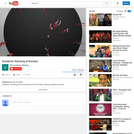
This video explains the concept of academic advising at the UFS.
- Subject:
- Education
- Material Type:
- Teaching/Learning Strategy
- Provider:
- University of the Free State
- Date Added:
- 01/15/2015

This video explains the concept of academic advising at the UFS.
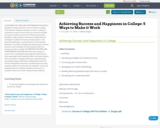
ACHIEVING SUCCESS AND HAPPINESS IN COLLEGE is designed to help students to be successful in college. This includes students who plan to enter a college or university, as well as those who are currently enrolled and want to make the most of it! This book provides insights to help students understand college life and strategies to address the most pressing issues—the personal challenges, social pressures, and academic demands. It includes thought-provoking quotes, humor, honesty, and techniques for becoming an effective learner as well as a leader.
ACHIEVING SUCCESS AND HAPPINESS IN COLLEGE describes how to play an active role in creating learning opportunities that are both meaningful and inspiring, which can help students down the path to a happy, productive, and personally rewarding college experience. Additionally, this book will be of significant interest to professionals who help students achieve success from an academic, social, and health perspective. Family members will see it as a valuable resource for their college-bound children.

LEARNING OBJECTIVESBy the end of this unit, you will be able to:Identify sources of test anxietyEmploy strategies for effectively preventing and controlling anxiety over tests.
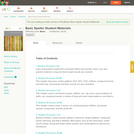
The Basic Speller is a spelling program for beginning students and consists of eight volumes of 48 lessons each. It presents lessons and practice for learning the relationships between sounds and their spellings.

The Basic Speller is a spelling program for beginning students and consists of eight volumes of 48 lessons each. It presents lessons and practice for learning the relationships between sounds and their spellings.
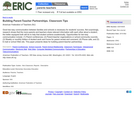
Good two-way communication between families and schools is necessary for students' success. Not surprisingly, research shows that the more parents and teachers share relevant information with each other about a student, the better equipped both will be to help that student achieve academically. Opportunities for two-way communication include: (1) Parent conferences; (2) Parent-teacher organizations or school community councils; (3) Weekly or monthly folders of student work sent home for parent review and comment; (4) Phone calls; and (5) E-mail or school Web site. This paper presents ideas for building parent-teacher partnerships.

During the Spring 2022 semester, I had the privilege to interview numerous teachers, administrators, and students at my college (RCTC) and our local public high schools (RPS) about developing a career exploration curriculum for undecided high school students. Based on these interviews, I have developed a set of curricular resources that encourages student exploration and planning. If you have any questions, or just want to connect, please email me at <mike.mutschelknaus@rctc.edu> I look forward to hearing from you.

LEARNING OBJECTIVESBy the end of this section, you will be able to:Differentiate between “job” and “career”Describe the stages of career development and identify the stage you’re currently inExplain the five-step process for choosing a careerList key strategies for selecting a college majorIdentify the relationship between college majors and career paths (both why they matter and why they don’t)Identify specific skills and transferable skills that will be valuable for your career path and how to acquire them

Being in control of your life and having realistic expectations about your day-to-day challenges are the keys to stress management, which is perhaps the most important ingredient to living a happy, healthy and rewarding life. —Marilu Henner, actressLEARNING OBJECTIVESBy the end of this section, you will be able to:Explore practices for ensuring mental health and emotional balance in your lifeIdentify sources, symptoms, and strategies for managing stressIdentify techniques for developing and maintaining healthy eating habitsDescribe the major risks of an unhealthy diet and the benefits of healthy eatingIdentify the benefits of regular exercise, for both body and brainIdentify the benefits of sleep for physical and mental healthExplain what substance use and abuse is and identify the warning signs that help may be neededIdentify sexually healthy behaviors, including protecting against unwanted pregnancy and sexually transmitted diseaseIdentify the risks of sexual assault, including date rape, and where to go for helpDefine and practice safety consciousness
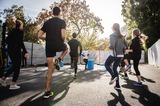
Chapter 16 covers mental and physical health and why both are important to student success. This chapter includes the topic of stress and stress management, healthy eating, the importance of exercise, and the importance of enough sleep. DISCLAIMER: This chapter addresses mental health concerns and is intended for educational purposes. It is not intended to diagnose or treat any mental illness. ACC students in need of mental health services can request an appointment with a Mental Health Counselor. If you or someone you know is in crisis or struggling with suicidal thoughts, call 988 (National Suicide and Crisis Lifeline), chat 988lifeline.org, or text "HELLO" to the Crisis Text Line (741741).

The cost of college should never discourage anyone from going after a valuable degree. –Arne Duncan, former United States Secretary of EducationLEARNING OBJECTIVESBy the end of this section, you will be able to:Establish financial goalsIdentify strategies for creating and maintaining a budgetDescribe available options for paying for collegeDescribe the benefits and risks of creditDevelop financial literacy skills to prepare for your financial future

LEARNING OBJECTIVESBy the end of this chapter, you will be able to:Define core values and identify your own personal core values.Explore your current life stage.Identify the benefits and rewards of setting goals.Identify short-term, mid-term, and long-term goals.Apply the SMART goal model to your goals.Brainstorm long-term, mid-term and short-term goals to create a Personal Action Plan.Identify the differences between intrinsic and extrinsic motivation.

LEARNING OBJECTIVESBy the end of this section, you will be able to:Define critical thinkingDescribe the role that logic plays in critical thinkingDescribe how both critical and creative thinking skills can be used to problem-solveDescribe how critical thinking skills can be used to evaluate informationApply the CRAAP test to evaluate sources of informationIdentify strategies for developing yourself as a critical thinker
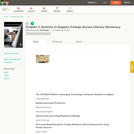
This resource guide begins by outlining the theory underlying the literacy work and then lays out the framework for the supports included in the Readers series. Subsequent chapters describe and illustrate the specific content literacy and language development strategies that have been chosen as being of particularly high impact. Although most of the strategies can be used in multiple ways, we have chosen to present them as occurring "Before, During and After Reading" because of the importance of this mental model in effective content literacy instruction.

As college freshmen transition into the higher education arena, student life becomes increasingly heavy and complex with work, academic, social, athletic, and other demands that can be difficult to manage. Depending on the number of courses a student is taking in the semester, there will be competing priorities depending on each classroom's expectations and assignments to be completed. Helping students to learn how to plan and prioritize their commitments is a critical lesson. Through the guidance of their instructor, students will learn time management skills by thinking about time-wasting behaviors that contribute to the inability to manage time effectively.

As college freshmen transition into the higher education arena, student life becomes increasingly heavy and complex with work, academic, social, athletic, and other demands that can be difficult to manage. Depending on the semester schedule, there will be competing priorities depending on each classroom's expectations and assignments to be completed. Helping students learn how to plan and prioritize their commitments is a critical lesson. Through this lesson, students will learn time management skills and think about time-wasting behaviors and interruptions that contribute to their inability to manage time effectively.
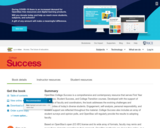
OpenStax College Success is a comprehensive and contemporary resource that serves First Year Experience, Student Success, and College Transition courses. Developed with the support of hundreds of faculty and coordinators, the book addresses the evolving challenges and opportunities of today’s diverse students. Engagement, self-analysis, personal responsibility, and student support are reflected throughout the material. College Success also includes an array of student surveys and opinion polls, and OpenStax will regularly provide the results to adopting faculty.
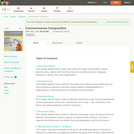
This textbook follows California Language Arts Standards for grades 9-12 to provide a generalized understanding of composition and to serve as a supplementary aid to high school English teachers.

Teachers strive to develop partnerships with parents to support student learning. Strong communication is fundamental to this partnership and to building a sense of community between home and school. This article provides a range of communication opportunities available to teachers, including the emergency use of technology. Barriers to communication are considered in conjunction with potential solutions.

LEARNING OBJECTIVESBy the end of this section, you will be able to:Define critical thinkingDescribe the role that logic plays in critical thinkingDescribe how both critical and creative thinking skills can be used to problem-solveDescribe how critical thinking skills can be used to evaluate informationApply the CRAAP test to evaluate sources of informationIdentify strategies for developing yourself as a critical thinker